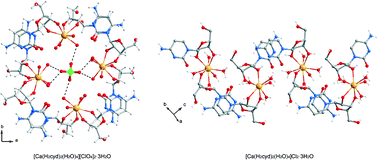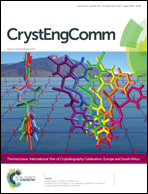Ca2+ metal ion adducts with cytosine, cytidine and cytidine 5′-monophosphate: a comprehensive study of calcium reactivity towards building units of nucleic acids†‡
Abstract
Six new Ca(II) adducts of formulae [Ca(cyt)2(H2O)4][ClO4]2·2cyt·2H2O (1), [Ca2(cyt)2(H2O)4(ClO4)4] (2), [Ca2(cyt)4(H2O)4Cl2]Cl2 (3), [Ca(H2cyd)2(H2O)4][ClO4]2·3H2O (4), [Ca(H2cyd)2(H2O)4]Cl2·3H2O (5) and [Ca2(CMP)2(H2O)11]·5H2O (6) [cyt = cytosine, H2cyd = cytidine, CMP = cytidine 5′-monophosphate] have been synthesized and structurally characterized. They reveal classical as well as uncommon structures, with H2cyd and CMP showing unprecedented binding sites for the calcium ion. The structure of compound 1 consists of monomeric [Ca(cyt)2(H2O)4]2+ cations and uncoordinated ClO4− anions as well as lattice nucleobase molecules. The structures of compounds 2 and 3 contain either neutral (2) or cationic (3) dinuclear entities. They have in common a bis-μ-carboxylate bridged [Ca2(cyt)2]4+ dinuclear core, where each cytosine molecule shows coordination simultaneously through O2–N3. The coordination sphere of each calcium ion in 2 is completed by two cis water molecules and two ClO4− groups, the latter either in a mono- or in a bis-monodentate fashion. In the structure of 3, the dinuclear entities are cationic due to the direct metal coordination of only two of four Cl− anions, the remaining two being engaged as counterions in hydrogen bonds with the metal complex. The coordination sphere of each calcium ion in 3 is completed by two trans water molecules and an additional cytosine molecule, coordinated this time via O2 only. Compounds 4 and 5 are, like 1 and 3, ionic salts. They share the same [Ca(H2cyd)2(H2O)4]2+ cationic unit and differ by the supramolecular packing motif generated with the aid of water molecules of crystallization and the specific counterions in each case [ClO4− in 4 and Cl− in 5]. The structure of compound 6 consists of neutral [Ca2(CMP)2(H2O)11] asymmetric moieties and crystallization water molecules. Each dimer contains two Ca(II) ions in a slightly different coordination environment and two CMP di-anions exhibiting the chelating coordination mode through the ribose O2′ and O3′ hydroxyl groups and each interacting with a calcium ion. One of them is further coordinated via the nucleobase O2 oxygen atom toward the exogenous calcium ion, thus building up the dinuclear unit. The lack of coordination of Ca2+ ions to phosphate groups observed in 6 is unusual.

- This article is part of the themed collection: International Year of Crystallography Celebration: Europe and South Africa

 Please wait while we load your content...
Please wait while we load your content...